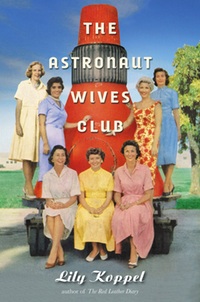Review: The Astronaut Wives Clubby Jeff Foust
|
| They had shared experiences as the wives of men who previously had been combat and test pilots and now, thrown together in a bright media spotlight, bonded. |
There was no such equal footing fifty years ago, when the astronaut corps was all male, but as Lily Koppel writes in The Astronaut Wives Club, the women married to those astronauts were no strangers to risk and stress, albeit of a very different kind. When NASA announced the original Mercury Seven astronauts in 1959, they became instant public figures—and, by extension, so did their wives. They were subject to the same media scrutiny as their husbands, with the pressure to “be not only the perfect fifties housewife, but the perfect astronaut’s wife, molded like the popular Barbie doll” that had been recently introduced, Koppel writes. Moreover, they had been instructed by NASA to shield their husbands from any kind of day-to-day stresses that could impair their performance or, worse, cost them a flight assignment.
The wives of the Mercury Seven were, in many respects, a diverse group: Trudy Cooper was a licensed pilot, Jo Schirra was “Navy royalty” as the daughter of an admiral, while Rene Carpenter’s striking looks reportedly made President Kennedy declare that she was his favorite among the Mercury Seven wives. But they had shared experiences as the wives of men who previously had been combat and test pilots and now, thrown together in a bright media spotlight, bonded, often because they had no one else to turn to but each other.
Koppel follows these astronaut wives from the beginning of the Mercury program through Apollo, as their ranks swell with the addition of more astronauts and as they settle in Houston. The stresses on them don’t lessen, though, as they’re required to maintain perfect appearances in public while worrying about the safety of their husbands—and, in many cases, whether their husbands are cheating on them with Florida-based girlfriends, the “Cape Cookies.” Meanwhile, what it meant to be a perfect wife—astronaut wife or otherwise—was changing as part of the broader societal upheavals of the 1960s.
| Out of the first three astronaut classes, totaling thirty men, only seven couples would remain married. |
The club in the title of the book formally got organized in the mid-1960s, when the astronaut corps had grown to a size where “official, organized meetings” of the informal club of astronaut wives were necessary. (Interestingly, in an interview published in June issue of Air & Space magazine, Janet Evans, wife of Apollo 17 astronaut Ron Evans, said there really was no such club: “There was no Astronaut Wives Club: We didn’t feel that we were any different than anybody else and didn’t want to set ourselves apart. The only time we wavered from that is when we had a luncheon and invited all of the prisoner-of-war wives from the area.”) Regardless of its formality, though, the club was a support mechanism for the wives, but still insufficient to protect them from all the stresses of their roles. That eventually led to, among other things, a wave of divorces, once the social—and, for the men, career—stigma associated with them faded: Out of the first three astronaut classes, totaling thirty men, only seven couples would remain married.
The idea of viewing the early Space Age through the lens of the experiences of the astronauts’ wives is not totally novel: an episode of the late-90s HBO series From the Earth to the Moon, titled “The Original Wives’ Club,” looked specifically at how the wives of the second astronaut class, the “New Nine,” dealt with these challenges. The Astronaut Wives Club, though, is a far more detailed examination of how these women dealt with their unique circumstances, and one that’s a pleasure to read, particularly as you reflect on how far women and NASA have come in the last half century.
